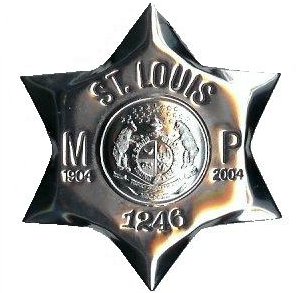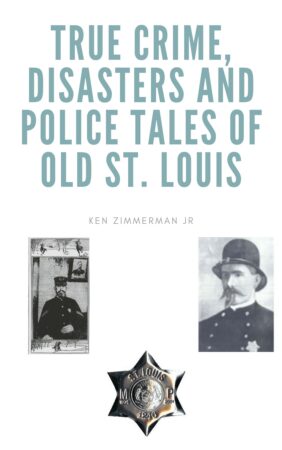La polizia identifica l'assassino di Walsh
Quando uomini sconosciuti spararono all'agente Michael Walsh con il raffreddore, notte nebbiosa nel mese di dicembre 1880, St. Louis credeva che il sospetto potesse essere un ladro di saloon e di generi alimentari che lavorava nella zona. Tuttavia, St. Gli investigatori di Louis non erano riusciti a trovare la squadra antifurto. Un prigioniero loquace ha chiarito il mistero in aprile 1881.
Police arrested Charlie Wilson with his friend Tom Higgins for saloon burglaries in Alton, Illinois during February 1881. Higgins engaged in a gun fight with officers. The Alton Police Officers shot Higgins through the chest. Because doctors did not expect Higgins to live, Alton Police relaxed their vigilance. Higgins escaped but police believed Higgins died from the gunshot wound.

All'inizio St. Louis Distintivo della polizia dal pubblico dominio
Wilson began to reveal details of burglaries to a fellow prisoner, who alerted the warden. St. Louis Police asked the warden to gather any information he could. Over the following weeks, Wilson revealed details about burglaries including a serious assault and the saloon burglaries on the night that burglars killed Officer Walsh.
The informant would write down everything Wilson told him after Wilson fell asleep. The prisoner would then toss the information out into the hallway, where the warden would retrieve it every morning. One of the things Wilson revealed to the authorities was his belief that Tom Higgins was still alive.
Wilson and Higgins frequented an African American brothel, a 614 Elm Street in St. Louis, run by Sadie Ross. The five or six men in the burglary team often met at the brothel, planned jobs, and patronized the prostitutes. Unlike his friends, Tom Higgins had a meaningful relationship with one of the girls, Jessie Liverpool.
Wilson felt that if anyone knew where Higgins was hiding, it would be Jessie Liverpool. St. Louis Police raided Sadie Ross’ establishment often but could not find information leading them to Higgins. The detectives got a break when a young prostitute named Hattie Wilson told them where Jessie Liverpool hid her letters from Higgins.
St. Louis Police learned that Higgins sent Liverpool a letter asking her to meet him at another brothel in Louisville, Kentucky. He intended to set up operations in Louisville as St. Louis had become too hot. St. Louis Police arranged for Louisville Police to pick up Higgins.
Higgins agreed to St. Louis Police transporting him back to St. Louis figuring he would escape on the way back. Tuttavia, St. Louis Police were determined that he would not get away. St. Louis Police Officers safely delivered Higgins to the Four Courts building.
Hattie Wilson filled in the blanks for investigators. Wilson and Tom Higgins were burglarizing saloons in one area, while their other team led by Ed Higgins, no relation to Tom, was working in another area. When Wilson and Tom Higgins heard the police officers rapping the pavement, they figured police had discovered the burglaries.
Wilson and Tom Higgins were trying to get back to Sadie Ross’ house when Officer Walsh stepped out of the fog. He grabbed Charlie Wilson’s arm and asked, “Where are you in a hurry to?” Higgins was passing by on the inside, turned back to Walsh after he passed him, leveled his revolver at Walsh’s head and pulled the trigger. Walsh fell mortally wounded.
Wilson and Higgins arrived at Sadie Ross’ house around 3:30 antimeridiano, an hour and a half after the shooting. Wilson and Tom Higgins were still arguing over the Walsh killing. Wilson told Higgins shooting Walsh was wrong.
The men pulled more burglaries including one where another confederate hit an aged saloon keeper with a lead pipe. Per fortuna, the saloon keeper lived but the men decided to move to Alton.
After police shot Tom Higgins in Alton, Jessie Liverpool paid Dr. Coryell $53 for a two-week stay as he recovered from his wounds in St. Louis. Higgins left for Louisville once he healed.
Solving the crime was not as easy as convicting Higgins. The case against him was based on the testimony of a confederate and a prostitute. I have never found any evidence that prosecutors charged Higgins with Walsh’s murder.
I am often surprised at how criminals killed St. Louis Police Officers but escaped any punishment. Spesso, the killers escaped punishment or served short prison sentences of less than five years.
You can leave a comment or ask a question about this or any post on my Pagina Facebook.
Source: St. Louis Post-Dispatch, Aprile 30, 1881, edition, p. 1
Pin It

